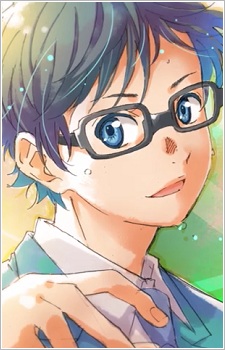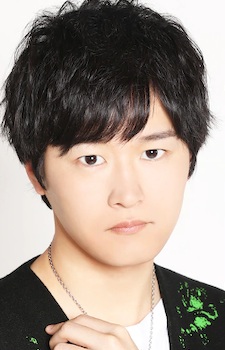
Shigatsu wa Kimi no Uso
Summary: Kousei Arima is a child prodigy known as the "Human Metronome" for playing the piano with precision and perfection. Guided by a strict mother and rigorous training, Kousei dominates every competition he enters, earning the admiration of his musical peers and praise from audiences. When his mother suddenly passes away, the subsequent trauma makes him unable to hear the sound of a piano, and he never takes the stage thereafter.
Nowadays, Kousei lives a quiet and unassuming life as a junior high school student alongside his friends Tsubaki Sawabe and Ryouta Watari. While struggling to get over his mother's death, he continues to cling to music. His monochrome life turns upside down the day he encounters the eccentric violinist Kaori Miyazono, who thrusts him back into the spotlight as her accompanist. Through a little lie, these two young musicians grow closer together as Kaori tries to fill Kousei's world with color.
[Written by MAL Rewrite]
Description
Kousei Arima is a child prodigy known as the "Human Metronome" for playing the piano with precision and perfection. Guided by a strict mother and rigorous training, Kousei dominates every competition he enters, earning the admiration of his musical peers and praise from audiences. When his mother suddenly passes away, the subsequent trauma makes him unable to hear the sound of a piano, and he never takes the stage thereafter.
Nowadays, Kousei lives a quiet and unassuming life as a junior high school student alongside his friends Tsubaki Sawabe and Ryouta Watari. While struggling to get over his mother's death, he continues to cling to music. His monochrome life turns upside down the day he encounters the eccentric violinist Kaori Miyazono, who thrusts him back into the spotlight as her accompanist. Through a little lie, these two young musicians grow closer together as Kaori tries to fill Kousei's world with color.
[Written by MAL Rewrite]
Available At
Warning: Array to string conversion in /home/hianime.me.uk/public_html/anime.php on line 243
Array
Warning: Array to string conversion in /home/hianime.me.uk/public_html/anime.php on line 243
Array
Shigatsu wa Kimi no Uso Trailers
Shigatsu wa Kimi no Uso Pictures
Shigatsu wa Kimi no Uso Review
Shigatsu wa Kimi no Uso — Kousei Arima is a child prodigy known as the "Human Metronome" for playing the piano with precision and perfection. This overview is intentionally spoiler-free and focuses on tone and intent rather than plot specifics.
Thematically, It sits firmly within Drama, Romance conventions as a TV work and has garnered attention (MAL score: 8.64). This work explores character dynamics, tonal shifts, and the interplay between narrative ambition and execution. The story's pacing and tonal choices are crafted to complement the central ideas, often emphasizing atmosphere and emotional truth over explicit exposition. The show's ability to evoke a consistent mood — whether melancholic, exuberant, or contemplative — is a recurring strength, and the scenes are constructed so viewers can infer stakes without needing explicit spoilers.
Characterization is a core pillar here. Protagonists and supporting figures are written with distinct motivations and narrative roles; even when archetypal, the series invests in small behavioral details that make choices feel earned. Character arcs are handled with an eye for gradualism: development often arrives through incremental beats rather than abrupt, expository shifts. The interactions between characters create texture, and relationships are used to illuminate both personal flaws and larger thematic concerns.
On the visual front, production values play a significant role. The animation quality varies by sequence but frequently showcases thoughtful direction and composition. Background art, framing, and color palettes are used deliberately to support tone — quieter scenes favor muted palettes while action or heightened emotional beats employ brighter, more kinetic visuals. Direction choices, such as camera movement and shot selection, often elevate scenes beyond their raw script, creating moments that linger in the viewer's mind.
The soundscape — score, incidental music, and sound design — complements the visual language. Music cues are placed to maximize emotional resonance without manipulating the audience with melodrama; this restraint often leads to more authentic emotional payoff. Sound design punctuates key moments, and when the series leans on silence, those quieter moments are given weight by measured audio choices.
Pacing and structure are handled with craft. Episodes are arranged to build tension and release methodically, and the narrative rarely rushes through important emotional beats. That said, the deliberate pacing may feel slow to viewers who prefer faster plot turnover; the reward is greater nuance and an accumulation of meaning across the series. Accessibility is generally good — one can appreciate surface-level pleasures, while repeat or attentive viewing reveals additional layers.
No title is without flaws. Occasional unevenness in subplots or variable animation across episodes can be distracting. Some tonal shifts might feel abrupt if you expect uniformity; others will argue that those shifts are purposeful. These are worth noting, but they seldom undercut the larger achievements of the work.
In sum, Shigatsu wa Kimi no Uso offers a rich experience for viewers who value character-driven storytelling, considered visual design, and a soundtrack that supports rather than overwhelms. For fans of Drama, Romance, this is an especially rewarding watch. It's recommended for those who appreciate layered narratives and artistry in animation, and best approached with patience and attention to nuance.
Characters & Voice Actors

Arima, Kousei
Main

Arima, Kousei
Main

Arima, Kousei
Main

Arima, Kousei
Main

Arima, Kousei
Main

Miyazono, Kaori
Main

Miyazono, Kaori
Main

Miyazono, Kaori
Main

Miyazono, Kaori
Main

Miyazono, Kaori
Main

Sawabe, Tsubaki
Main

Sawabe, Tsubaki
Main

Sawabe, Tsubaki
Main

Sawabe, Tsubaki
Main

Sawabe, Tsubaki
Main

Watari, Ryouta
Main

Watari, Ryouta
Main

Watari, Ryouta
Main

Watari, Ryouta
Main

Watari, Ryouta
Main
Staff

Fukushima, Yuuichi
Producer

Kimura, Makoto
Producer

Saitou, Shunsuke
Producer

Tateishi, Kensuke
Producer

Fujiyama, Naokado
Assistant Producer

Ishikawa, Tatsuya
Assistant Producer

Kawazoe, Chitose
Assistant Producer

Yamatani, Nakuru
Assistant Producer

Ishiguro, Kyouhei
Director, Episode Director, Storyboard

Aketagawa, Jin
Sound Director

Harada, Takahiro
Episode Director

Ibata, Yoshihide
Episode Director, Storyboard

Ishihama, Masashi
Episode Director, Storyboard

Ishii, Toshimasa
Episode Director, Storyboard

Iwata, Kazuya
Episode Director

Kawakoshi, Takahiro
Episode Director

Kojima, Takashi
Episode Director, Animation Director, 2nd Key Animation, In-Between Animation, Key Animation

Kouno, Ayako
Episode Director

Kuroki, Miyuki
Episode Director, Storyboard, Key Animation, 2nd Key Animation

Majima, Takahiro
Episode Director